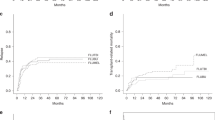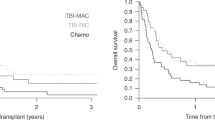Abstract
The goal of this analysis was to define the role of the moderate-intensity fludarabin Ara-C amsacrin (FLAMSA)-reduced intensity conditioning (RIC) regimen for patients with high-risk AML undergoing allogeneic SCT (alloSCT) in first CR1. High-risk was defined by (1) AML secondary to MDS or radio/chemotherapy, (2) unfavorable cytogenetics or (3) delayed response to induction chemotherapy. A total of 23 of 44 AML patients referred to the University of Munich for alloSCT in CR1 between 1999 and 2006 fulfilled these criteria and received FLAMSA chemotherapy, followed by RIC (4 Gy TBI/cyclophosphamide/ATG) for alloSCT. Twenty-two patients engrafted, one died in aplasia. Two-year cumulative incidences for relapse and nonrelapse mortality (NRM) were 4.6 and 22.5%, respectively. Four-year overall and leukemia-free survival was 72.7% (median follow-up among survivors: 35 months). The results of this high-risk cohort were compared to the outcome of 21 consecutive standard-risk patients <55 years, who had received standard, myeloablative sibling SCT in CR1 AML within the same center and time period. Survival and cumulative incidences of relapse and NRM were identical in both groups. In conclusion, the FLAMSA-RIC regimen produces long-term remission in a high proportion of patients with high-risk AML transplanted in CR1. In this cohort, FLAMSA-RIC showed equivalent antileukemic activity as compared to the standard protocols.
This is a preview of subscription content, access via your institution
Access options
Subscribe to this journal
Receive 12 print issues and online access
$259.00 per year
only $21.58 per issue
Buy this article
- Purchase on Springer Link
- Instant access to full article PDF
Prices may be subject to local taxes which are calculated during checkout

Similar content being viewed by others
References
Lowenberg B, Downing J, Burnett A . Acute myeloid leukemia. N Engl J Med 1999; 341: 1051–1062.
Grimwade D, Walker H, Oliver F, Wheatley K, Harrison C, Harrison G et al. The importance of diagnostic cytogenetics on outcome in AML: analysis of 1,612 patients entered into the MRC AML 10 trial. The Medical Research Council Adult and Children's Leukaemia Working Parties. Blood 1998; 92: 2322–2333.
Slovak ML, Kopecky KJ, Cassileth PA, Harrington DH, Theil KS, Mohamed A et al. Karyotypic analysis predicts outcome of preremission and postremission therapy in adult acute myeloid leukemia: a Southwest Oncology Group/Eastern Cooperative Oncology Group Study. Blood 2000; 96: 4075–4083.
Byrd JC, Mrozek K, Dodge RK, Carrol AJ, Edwards CG, Arthur DC et al. Pretreatment cytogenetic abnormalities are predictive of induction success, cumulative incidence of relapse, and overall survival in adult patients with de novo acute myeloid leukemia: results from Cancer and Leukemia Group B (CALGB 8461). Blood 2002; 100: 4325–4336.
Wheatley K, Burnett A, Goldstone A, Gray RG, Hann I, Harrison G et al. A simple, robust, validated and highly predictive index for the determination of risk-directed therapy in acute myeloid leukaemia derived from the MRC AML 10 trial. Br J Haematol 1999; 107: 69–79.
Kern W, Haferlach T, Schoch C, Loffler H, Gassmann W, Heinecke A et al. Early blast clearance by remission induction chemotherapy is a major independent prognostic factor for both achievement of complete remission and long-term outcome in acute myeloid leukemia: data from the German AML Cooperative Group (AMLCG) 1992 Trial. Blood 2003; 101: 64–70.
Appelbaum FR . Who should be transplanted for AML. Leukemia 2001; 15: 680–682.
Schoch C, Kern W, Schnittger S, Hiddemann W, Haferlach T . Karyotype is an independent prognostic parameter in therapy-related acute myeloid leukemia (t-AML): an analysis of 93 patients with t-AML in comparison to 1092 patients with de novo AML. Leukemia 2004; 18: 120–125.
Gale RP, Horowitz MM, Weiner RS, Ash RC, Atkinson K, Babu R et al. Impact of cytogenetic abnormalities on outcome of bone marrow transplants in acute myelogenous leukemia in first remission. Bone Marrow Transplant 1995; 16: 203–208.
Armand P, Kim HT, DeAngelo DJ, Ho VT, Cutler CS, Stone RM et al. Impact of cytogenetics on outcome of de novo and therapy-related AML and MDS after allogeneic transplantation. Biol Blood Marrow Transplant 2007; 13: 646–655.
Keating S, Suciu S, de Witte T, Mandelli F, Willemze R, Resegotti L . Prognostic factors of patients with acute myeloid leukemia allografted in first CR: an analysis of the EORTC/GIMEMA AML 8A trial. Bone Marrow Transplant 1996; 17: 993–1001.
Witherspoon RP, Deeg HJ, Storer B, Anasetti C, Storb R, Appelbaum FR . Hematopoietic stem-cell transplantation for treatment-related leukemia or myelodysplasia. J Clin Oncol 2001; 19: 2134–2141.
Martino R, Caballero MD, Simon JA, Canals C, Solano C, Urbano-Ispizua A et al. Evidence for a graft-versus-leukemia effect after allogeneic peripheral blood stem cell transplantation with reduced-intensity conditioning in acute myelogenous leukemia and myelodysplastic syndromes. Blood 2002; 100: 2243–2245.
Bertz H, Potthoff K, Finke J . Allogeneic stem-cell transplantation from related and unrelated donors in older patients with myeloid leukemia. J Clin Oncol 2003; 21: 1480–1484.
Wong R, Giralt SA, Martin T, Couriel DR, Anagnostopoulos A, Hosing C et al. Reduced-intensity conditioning for unrelated donor hematopoietic stem cell transplantation as treatment for myeloid malignancies in patients older than 55 years. Blood 2003; 102: 3052–3059.
Taussig DC, Davies AJ, Cavenagh JD, Oakervee H, Syndercombe-Court D, Kelsey S et al. Durable remissions of myelodysplastic syndrome and acute myeloid leukemia after reduced-intensity allografting. J Clin Oncol 2003; 21: 3060–3065.
de Lima M, Couriel D, Thall PF, Wang X, Madden T, Jones R et al. Once-daily intravenous busulfan and fludarabine: clinical and pharmacokinetic results of a myeloablative, reduced-toxicity conditioning regimen for allogeneic stem cell transplantation in AML and MDS. Blood 2004; 104: 857–864.
Stelljes M, Bornhauser M, Kroger M, Beyer J, Sauerland MC, Heinecke A et al. Conditioning with 8Gy total body irradiation and fludarabine for allogeneic hematopoietic stem cell transplantation in acute myeloid leukemia. Blood 2005; 106: 3314–3321.
Schmid C, Schleuning M, Ledderose G, Tischer J, Kolb HJ . Sequential regimen of chemotherapy, reduced-intensity conditioning for allogeneic stem-cell transplantation, and prophylactic donor lymphocyte transfusion in high-risk acute myeloid leukemia and myelodysplastic syndrome. J Clin Oncol 2005; 23: 5675–5687.
Schmid C, Schleuning M, Schwerdtfeger R, Hertenstein B, Mischak-Weissinger E, Bunjes D et al. Long term survival in refractory acute myeloid leukemia after sequential treatment with chemotherapy and reduced intensity conditioning for allogeneic stem cell transplantation. Blood 2006; 108: 1092–1099.
Schlenk RF, Brenner A, Krauter J, Büchner T, Sauerland C, Ehninger G et al. Individual patient data-based meta-analysis of patients aged 16 to 60 years with core binding factor acute myeloid leukemia: A Survey of the German Acute Myeloid Leukemia Intergroup. J Clin Oncol 2004; 22: 3741–3750.
Chason B . Revised criteria of the international working group for diagnostics, standardization of response criteria, treatment outcomes, and reporting standards for therapeutic trials in acute myeloid leukemia. J Clin Oncol 2003; 21: 4642–4649.
Sorror ML, Maris M, Storb R, Baron F, Sandmaier BM, Maloney D et al. Hematopoietic cell transplantation (HCT)-specific comorbidity index: a new tool for risk assessment before allogeneic HCT. Blood 2005; 106: 2912–2919.
Sullivan KM . Graft-versus-host-disease. In: Thomas E, Blume K, Forman SJ (eds). Hematopoietic Cell Transplantation, 2nd edn. Blackwell Science: Boston, 1999, pp 515–536. Ref Type: Serial (Book, Monograph).
Durnam DM, Anders KR, Fisher L, O'Quigley J, Bryant EM, Thomas ED . Analysis of the origin of marrow cells in bone marrow transplant recipients using a Y-chromosome-specific in situ hybridization assay. Blood 1989; 74: 2220–2226.
Anslinger K, Rolf B, Keil W . Evaluation and application of the AmpF/STR profiler plus PCR amplification kit in a Bavarian population sample. Int J Legal Med 2001; 114: 278–280.
Ferrant A, Labopin M, Frassoni F, Prentice HG, Cahn JY, Blaise D et al. Karyotype in acute myeloblastic leukemia: prognostic significance for bone marrow transplantation in first remission: a European Group for Bone Marrow Transplantation Study. Blood 1997; 90: 2931–2938.
Cornelissen JJ, Van Putten W, Verdonck L, Theobald M, Jacky E, Daenen SMG et al. Results of a HOVON/SAKK donor versus no-donor analysis of myeloablative HLA-identical sibling stem cell transplantation in first remission acute myeloid leukemia in young and middle aged adults: benefits for whom? Blood 2007; 109: 3658–3666.
Hegenbart U, Niederwieser D, Sandmaier BM, Maris MB, Shizuru JA, Greinix H et al. Treatment for acute myelogenous leukemia by low-dose, total-body, irradiation-based conditioning and hematopoietic cell transplantation from related and unrelated donors. J Clin Oncol 2006; 24: 444–453.
Tauro S, Craddock C, Peggs K, Begum G, Mahendra P, Cook G et al. Allogeneic stem-cell transplantation using a reduced-intensity conditioning regimen has the capacity to produce durable remissions and long-term disease-free survival in patients with high-risk acute myeloid leukemia and myelodysplasia. J Clin Oncol 2005; 23: 9387–9393.
Van Besien K, Smith AS, Cao D, Rich S, Godley L, Jones D et al. Fludarabine, melphalan, and alemtuzumab conditioning in adults with standard-risk advanced acute myeloid leukemia and myelodysplastic syndrome. J Clin Oncol 2005; 23: 5728–5738.
Blaise D, Boiron JM, Faucher C, Mohty MBJO, Bardoux V, Perreau V et al. Reduced intensity conditioning prior to allogeneic stem cell transplantation for patients with AML as first-line treatment. Cancer 2005; 104: 1931–1938.
Clift RA, Buckner CD, Appelbaum FR, Bearman SI, Petersen FB, Fisher LD et al. Allogeneic marrow transplantation in patients with acute myeloid leukemia in first remission: a randomized trial of two irradiation regimens. Blood 1990; 76: 1867–1871.
de Lima M, Anagnostopoulos A, Munsell M, Shahjahan M, Ueno N, Ippoliti C et al. Nonablative versus reduced-intensity conditioning regimens in the treatment of acute myeloid leukemia and high-risk myelodysplastic syndrome: dose is relevant for long-term disease control after allogeneic hematopoietic stem cell transplantation. Blood 2004; 104: 865–872.
Aoudjhane M, Labopin M, Gorin N, Shimoni A, Ruutu T, Kolb H-J . Comparative outcome of reduced intensity and myeloablative conditioning regimen in HLA identical sibling allogeneic haematopoietic stem cell transplantation for patients older than 50 years of age with acute myeloblastic leukaemia: a retrospective survey from the Acute Leukaemia Working Party (ALWP) of the European Group for Blood and Marrow Transplantation (EBMT). Leukemia 2005; 19: 2304–2312.
Scott B, Sandmaier BM, Storer B, Maris MB, Sorror ML, Maloney DG . Myeloablative versus nonmyeloablative allogeneic transplantation for patients with myelodysplastic syndrome or acute myelogenous leukemia with multilineage dysplasia: a retrospective analysis. Leukemia 2006; 20: 128–135.
Shimoni A, Hardan I, Shem-Tov N, Yeshurun M, Avigdor A, Ben-Bassat I et al. Allogeneic haematopoietic stem-cell transplantation in AML and MDS using myeloablative versus reduced-intensity conditioning: the role of dose intensity. Leukemia 2006; 20: 322–328.
Author information
Authors and Affiliations
Corresponding author
Rights and permissions
About this article
Cite this article
Schmid, C., Schleuning, M., Hentrich, M. et al. High antileukemic efficacy of an intermediate intensity conditioning regimen for allogeneic stem cell transplantation in patients with high-risk acute myeloid leukemia in first complete remission. Bone Marrow Transplant 41, 721–727 (2008). https://doi.org/10.1038/sj.bmt.1705965
Received:
Revised:
Accepted:
Published:
Issue Date:
DOI: https://doi.org/10.1038/sj.bmt.1705965
Keywords
This article is cited by
-
Impact of induction chemotherapy with intermediate-dosed cytarabine and subsequent allogeneic stem cell transplantation on the outcome of high-risk acute myeloid leukemia
Journal of Cancer Research and Clinical Oncology (2022)
-
Conditioning with fludarabine and treosulfan compared to FLAMSA-RIC in allogeneic stem cell transplantation for myeloid malignancies: a retrospective single-center analysis
Annals of Hematology (2022)
-
Similar outcome after allogeneic stem cell transplantation with a modified FLAMSA conditioning protocol substituting 4 Gy TBI with treosulfan in an elderly population with high-risk AML
Annals of Hematology (2017)
-
Allogeneic stem cell transplantation in adult patients with acute myeloid leukaemia and 17p abnormalities in first complete remission: a study from the Acute Leukemia Working Party (ALWP) of the European Society for Blood and Marrow Transplantation (EBMT)
Journal of Hematology & Oncology (2017)
-
Incidence and management of hepatic severe veno-occlusive disease in 273 patients in a single centre with defibrotide
Bone Marrow Transplantation (2016)



